The OWC Aura Pro X2 SSD Review: An NVMe Upgrade For Older Macs
by Billy Tallis on June 5, 2019 10:15 AM ESTAnandTech Storage Bench - Light
Our Light storage test has relatively more sequential accesses and lower queue depths than The Destroyer or the Heavy test, and it's by far the shortest test overall. It's based largely on applications that aren't highly dependent on storage performance, so this is a test more of application launch times and file load times. This test can be seen as the sum of all the little delays in daily usage, but with the idle times trimmed to 25ms it takes less than half an hour to run. Details of the Light test can be found here. As with the ATSB Heavy test, this test is run with the drive both freshly erased and empty, and after filling the drive with sequential writes.
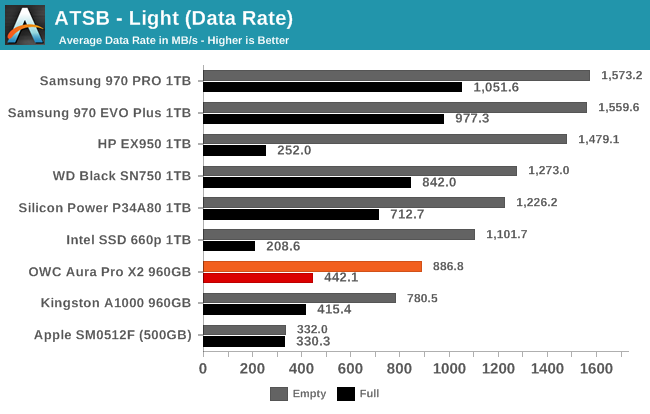
On the Light test, the OWC Aura Pro X2 again performs more like an entry-level NVMe SSD, but unlike the Heavy test there isn't a big gap between tiers of NVMe SSDs. The Aura Pro X2 clearly outperforms the older Apple SSD, even in the worst-case scenario of a full drive.
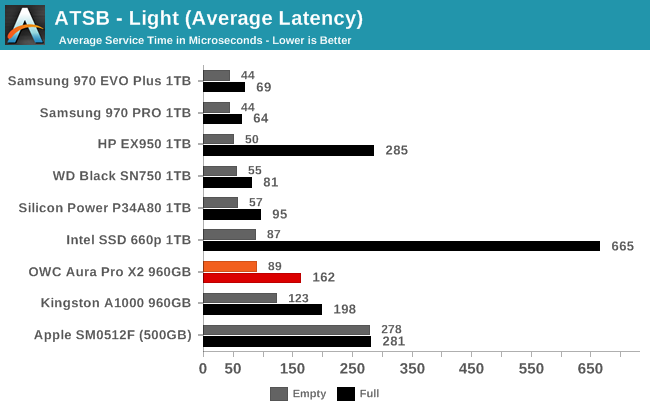
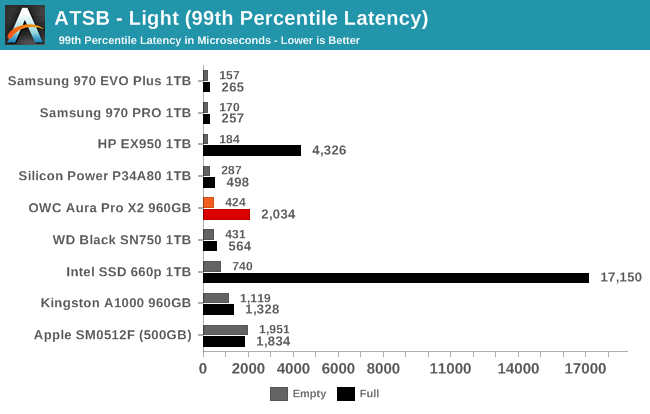
The average latency of the Aura Pro X2 during the Light test is a bit worse than most high-end NVMe SSDs, but isn't high enough to worry about. The 99th percentile latency is rather high for the worst-case test run on a full drive, but this 2ms is only marginally slower than the old Apple drive and is not even the worst we've seen from a SM2262EN drive.
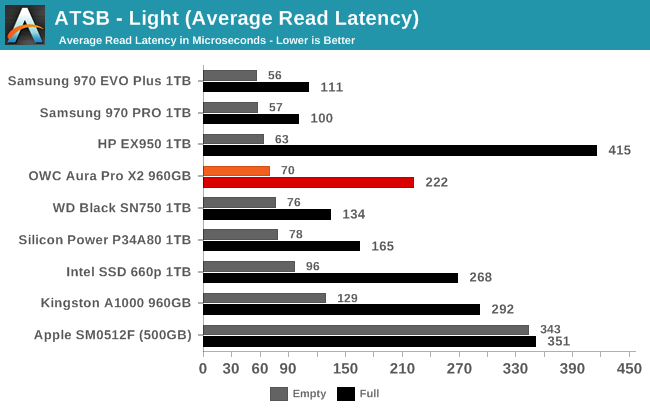

The average read latencies for the Aura Pro X2 on the Light test are competitive with high-end M.2 NVMe drives, though the latency for the full-drive test run is a bit high. The average write latency is clearly higher than typical for high-end NVMe drives, whether the test is run on a full or empty drive.
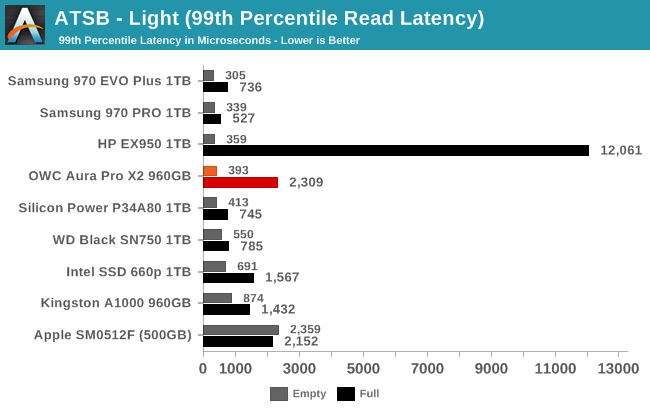
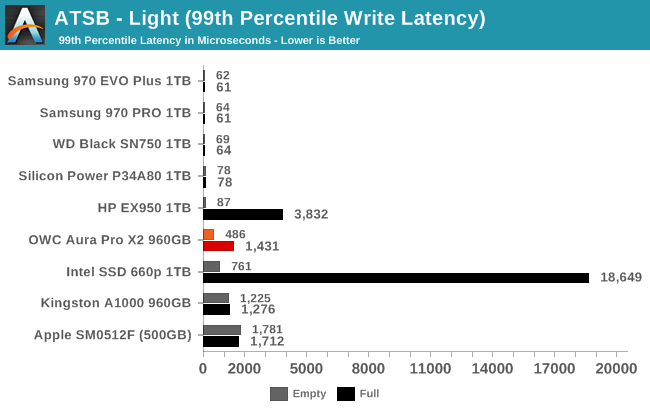
The high-end NVMe drives almost all have extremely low 99th percentile write latencies on the Light test, and the Aura Pro X2 can't match that performance even when the test is run on an empty drive. For reads, the 99th percentile latency is competitive when the test is run on an empty drive, and is on par with the old Apple SSD when full.
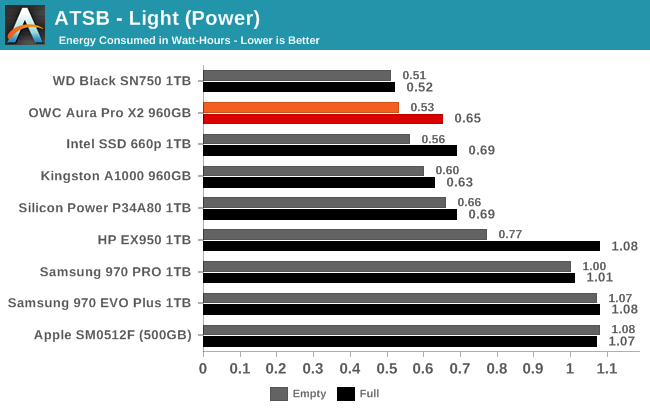
The OWC Aura Pro X2 saves a lot of power relative to the old Apple SSD or the fastest current NVMe SSDs. It doesn't quite match the WD Black SN750's efficiency, but it's better than we expected from a drive with the SM2262EN controller.










32 Comments
View All Comments
zepi - Wednesday, June 5, 2019 - link
Maybe you could list the Mac models that this works with in a nice table? It is not that long of a list.crimsonson - Wednesday, June 5, 2019 - link
Or you can go to the manufacturer's/seller's website and get the info?hasseb64 - Wednesday, June 5, 2019 - link
so why did you not post it here then?Ryan Smith - Thursday, June 6, 2019 - link
Hey, that's a good idea. Thanks! I've gone ahead and added a list.zepi - Thursday, June 6, 2019 - link
Thanks!I didn't even realise that this would actually be an upgrade path to my old rMBP13.
I wonder if the horrible mixed workload performance translate into a meaningfully slow zipping / unzipping performance.
leexgx - Monday, June 17, 2019 - link
maybe should add that its best not to even use these OWC ssds for these macs, as they have not fixed the power state bugs due to the mac it self (more so 2013-2015) and the SSD missing something proprietary (system has a high chance when it comes out of hibernate and crash as the drive is missing on wake up)ltcommanderdata - Wednesday, June 5, 2019 - link
https://forums.macrumors.com/threads/upgrading-201...Being a NVMe drive specifically designed to upgrade Macs, I don't suppose the OWC Aura Pro X2 solves the problem of NVMe drives failing to be detected upon wake from hibernation in 2013-2014 Macs? The current workarounds for that generation of Macs are to either disable hibernation reducing battery life or patching the BootRom which isn't user friendly.
It would have been interesting to see where Apple's Polaris NVMe drives stack up in your comparison since testing by @gilles_polysoft at Macrumors suggests it's still one of the fastest, most power efficient options compared to third-party SSDs. It was only offered officially in 2017 iMacs though so finding a pull or an Apple service provider willing to sell a new one to upgrade older Macs is difficult and expensive.
Skeptical123 - Wednesday, June 5, 2019 - link
That's a good pointzsero - Wednesday, June 5, 2019 - link
Yes, there is a big difference between 2013-2014 and 2015 Macbook Pros regarding how they work with NVMe drivers. After reading a _lot_ about it, I finally decided that for my 2013 rMBP 15 the best option is to buy an original "SSUBX" drive from eBay, as none of the NVMe drivers would work reliably.MamiyaOtaru - Thursday, June 6, 2019 - link
"I don't suppose the OWC Aura Pro X2 solves the problem of NVMe drives failing to be detected upon wake from hibernation in 2013-2014 Macs?"It does not. https://forums.macrumors.com/threads/owc-launches-... The OWC rep finally acknowledges it after mistakenly saying hibernation was fine for a couple pages. Disappointing lack of knowledge for the products he is shilling